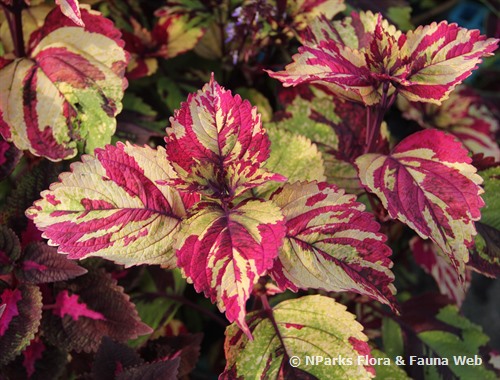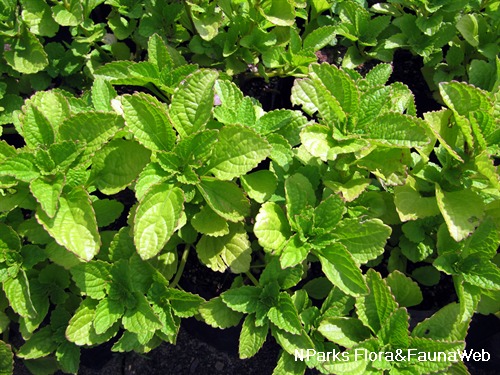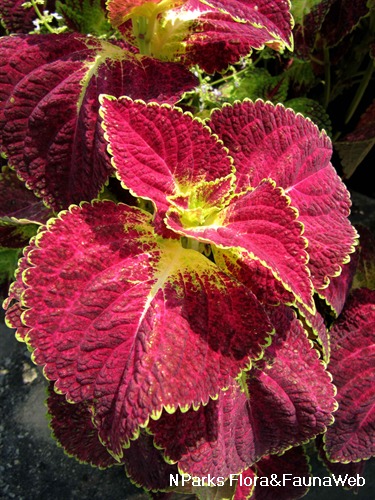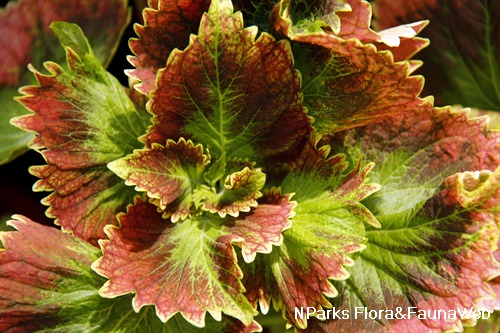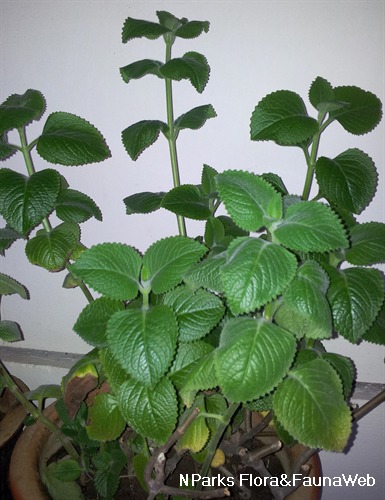
Back
Coleus scutellarioides 'Finger Paint'
| Family Name: | Lamiaceae (Labiatae) |
| Synonyms: | Plectranthus scutellarioides 'Finger Paint' |
| Common Name: | Coleus, Painted nettle |
Name
Classifications and Characteristics
| Plant Division | Angiosperms (Flowering Seed Plants) |
|---|---|
| Plant Growth Form | Shrub |
| Lifespan (in Singapore) | Perennial, Semi-Annual / Annual-Like, Annual |
| Mode of Nutrition | Autotrophic |
| Plant Shape | Shrubby |
Biogeography
| Native Distribution | Of horticultural origin |
|---|---|
| Preferred Climate Zone | Tropical, Sub-Tropical / Monsoonal, Temperate |
Description and Ethnobotany
| Growth Form | Annual herb to 60cm tall |
|---|---|
| Foliage | Leaves to 5 (-7)cm long by 5(-6)cm wide, pale lime green with maroon/ red blotches and pale yellow spots, Leaf margins crenate. |
| Stems | Herbaceous stem, turning to semi-woody at the base when mature. |
| Taxonomy | Solenostemon scutellarioides and Coleus blumei are synonyms and former names for this plant. |
| Cultivation | Water regularly and do not let soil dry out. Propagate by stem cuttings. Perennial plant but normally grown as annual in Singapore. Plant tends to get leggy, sparse and less vigorous with age (especially after flowering). Tip-prune to promote bushy growth, and remove flower shoots as they appear. |
| Etymology | The genus Plectranthus comes from Greek which means spur-shaped flowers. The specific epithet scutellarioides means small dish or sauce, in reference to the shape of persistent calyx after flowers fade. |
Landscaping Features
| Desirable Plant Features | Ornamental Foliage |
|---|---|
| Landscape Uses | Small Gardens, Flowerbed / Border, Container Planting |
Fauna, Pollination and Dispersal
| Fauna Pollination Dispersal Associated Fauna | Butterfly-Attracting |
|---|---|
| Pollination Method(s) | Biotic (Fauna) |
Plant Care and Propagation
| Light Preference | Full Sun, Semi-Shade |
|---|---|
| Water Preference | Lots of Water |
| Rootzone Tolerance | Moist Soils, Well-Drained Soils, Fertile Loamy Soils, Easy to Grow |
| Planting Remarks | It is advisable to start new plants by taking cuttings from the parent plant regularly as it behaves like an annual (dies after flowering/ setting seed). |
| Pruning | Plant becomes 'leggy' with age and regular pruning is advised; pruned branches can be used as cuttings. |
| Propagation Method | Stem Cutting |
Foliar
| Foliage Retention | Evergreen |
|---|---|
| Mature Foliage Colour(s) | Green, Green - Light Green, Red, Yellow / Golden, Patterned |
| Mature Foliage Texture(s) | Thin |
| Prominent Young Flush Colour(s) | Green, Green - Light Green, Red, Yellow / Golden, Patterned |
| Young Flush Texture(s) | Thin |
| Foliar Type | Simple / Unifoliate |
| Foliar Attachment to Stem | Petiolate |
| Foliar Shape(s) | Non-Palm Foliage (Ovate) |
| Foliar Venation | Pinnate / Net |
| Foliar Margin | Crenate |
| Foliar Apex - Tip | Acuminate |
Non - Foliar and Storage
| Stem Type & Modification | Herbaceous |
|---|---|
| Root Type | Underground |
Floral (Angiosperm)
| Flower & Plant Sexuality | Bisexual Flowers |
| Flower Grouping | Cluster / Inflorescence |
|---|---|
| Flower Location | Terminal |
| Flower Symmetry | Bilateral |
| Inflorescence Type | Raceme |
Image Repository
Others
| Master ID | 31539 |
|---|---|
| Species ID | 5938 |
| Flora Disclaimer | The information in this website has been compiled from reliable sources, such as reference works on medicinal plants. It is not a substitute for medical advice or treatment and NParks does not purport to provide any medical advice. Readers should always consult his/her physician before using or consuming a plant for medicinal purposes. |

